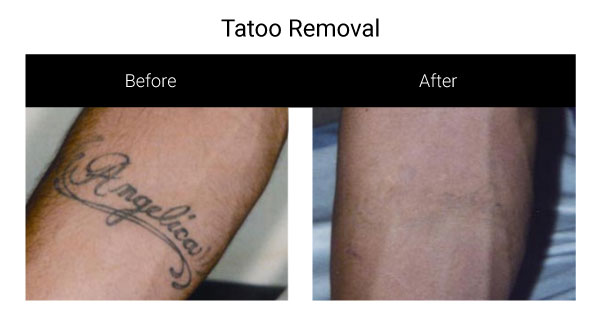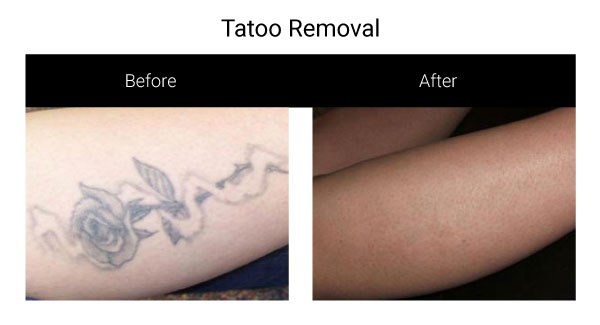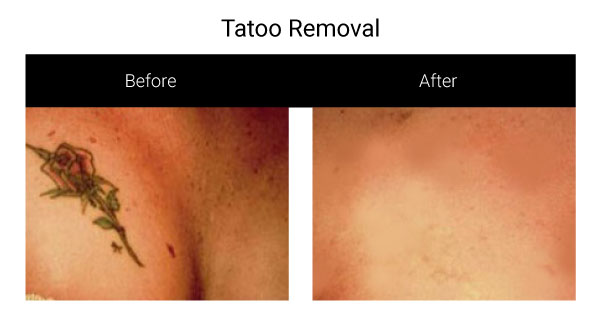Tattoo Removal
Laser Therapy for Tattoo Removal
Tattoos have always been a part of American mainstream culture and the last decade has seen an explosion of tattoo mania. It is estimated that more than 10 million Americans have at least one tattoo and tattooing is big business. However, in the last decade tattoo removal has become an even bigger business and it is estimated that more than 50% of individuals who have a tattoo, later regret having it and want it removed. Because tattoos are placed fairly deeply under the skin, for the past 3 decades removal methods (including excision, dermabrasion, chemical removal, and the earliest lasers) caused unacceptable levels of scarring. However, with the recent advances in medical technology, laser therapy has become the gold standard for removal of tattoos. If you have a tattoo that you wish to have partially or completely removed, you should first consider your options and decide which method might be best for you.
As an expert on tattoo removal, Dr. Tang was quoted in the San Jose Mercury News on why people might want tattoos removed — and which ink is the most likely to get taken off!
FAQ
Can all tattoos be removed?
Unfortunately, not all tattoos can be removed completely, but the majority can be. Tattoos are meant to be permanent and with recent ink technology and professional tattoo artists improving their skills, tattoos imprinted in the last decade are very difficult to remove. Even with the best technique, some residual scarring remains in a few cases.
How do lasers remove tattoos?
Lasers work by directing energy toward ink in the skin with highly concentrated colored light beams. These laser beams break up ink particles into tiny fragments which are later cleared up by the body’s scavenging cells. This process of fragmenting the ink particles requires numerous sessions depending on the depth of the ink level. The procedure is bloodless and no incisions are made. The laser selectively targets the pigment of the tattoo without damaging the surrounding skin. With deeper penetration of the skin and multiple sessions however, the heat generated by the lasers may cause pain and blister formation. Even though laser technology is refined, the chance of scarring is always present with multiple treatments.
Who is a candidate for laser tattoo removal?
Individuals with fair skin and superficially placed tattoos on the arms, chest, buttocks, or legs are the best candidates. Tattoos on dark-skinned individuals, or tattoos on the ankles or fingers (areas where there is less body fat), are the most difficult to treat and results are more variable. A thorough discussion with Dr. Tang can better determine the potential success rate of laser tattoo removal for any given tattoo and skin type. Consulting with a professional and reputable tattoo removal specialist who is experienced and understands the procedure is important to ensure proper treatment and candidacy.
What determines the success of tattoo removal?
Complete removal of a tattoo is based on several things. The size, location, application, age, and color of the tattoo all factor in, as well as the health of the patient and thus their body’s ability to heal. Newer tattoos are generally more difficult to remove. Tattoos that have dark ink are easier to remove while tattoos with yellow and red pigments are harder and require more treatments.
Does tattoo removal hurt?
Unfortunately, tattoos are painful when they are placed on the skin and they are just as painful when they are removed. The lasers generate rapid pulses which may feel different to each patient, but are generally uncomfortable. To minimize the pain, Dr. Tang recommends taking Tylenol one hour before the procedure. Pain medications that thin blood and promote bruising are not recommended. To further decrease the pain, Dr. Tang may apply a local anesthetic ointment on the tattoo a 30 minutes before the procedure to make the laser treatment more comfortable.
How long does each treatment take?
Laser treatment usually does not take more than a few minutes, yet this time frame varies greatly depending on the tattoo.
How many treatments will I need?
This all depends on the size, complexity, and color of the tattoo, the overall health of the patient, and whether the tattoos were done professionally or by an amater. Multiple sessions are required to remove most tattoos. Most simple tattoos are removed in 2-4 treatments. Professional tattoos usually require 6-10 treatments for complete clearing. Tattoos with red and red hues will require more treatments. Treatments are done usually once a month. At your complimentary consultation, Dr. Tang can provide you an approximate estimate on the number of treatments.
What happens after each treatment?
After each laser treatment, ice is immediately placed on the tattoo to minimize swelling and is continued for the next 4-6 hours. Direct sun exposure should be avoided for the several days. A hot shower in the area should also be avoided that night. Otherwise, the treated area should be cared for like sunburned skin.
What happens during the tattoo removal treatment?
Once the individual is ready for treatment, protective eye shields are worn to protect the eyes from the laser. The skin’s reaction to the laser is tested to determine the most effective energy. This is followed by the physician activating a small probe against the tattoo. Treatment continues with rapid pulses from the laser. Depending on the size of the tattoo, 10-30 pulses of the laser may be required in one session. Depending on the patient, some will require a topical anesthetic prior to the laser treatment.
Does the procedure have any side effects?
Side effects of laser procedures are generally few but may include hyperpigmentation (excessive color), or hypopigmentation (excessive fading) of skin. Other possible side effects include infection and a small chance of permanent scarring. The area may appear sunburned for a few months and ultimately this will pass.
What is the cost of laser tattoo removal?
Tattoo removal is considered a cosmetic procedure and is usually not covered by any medical insurance plans. Tattoo removal is much more expensive than tattoo placement. Laser tattoo removal can range from several hundred dollars to thousands of dollars depending upon the size, type, and location of the tattoo, as well as the number of visits required. At your complimentary consultation, Dr. Tang will give you at estimate.
Are there other tattoo removal methods?
There are other methods of tattoo removal, though most of them are generally ineffective at permanent removal and may result in a greater risk of scarring. Today laser therapy has replaced most other treatment options, and most tattoo removal specialists utilize laser technology as the sole tattoo removal treatment option. Some of the other methods include dermabrasion, camouflage, and excision of the tattoo. These methods may result in more damage to the skin and excess scarring. These techniques are usually used when laser is not an option. There are also tattoo removing creams on the market which are not proven to work. They are thought to assist with sloughing off skin cells and thus the tattoo layer by layer, which usually takes a long time and still may not reach the depths of the tattoo ink.



Laser Tattoo Removal:
*The above pictures are actual patients but the individual results will vary and these results may not occur in all patients.
